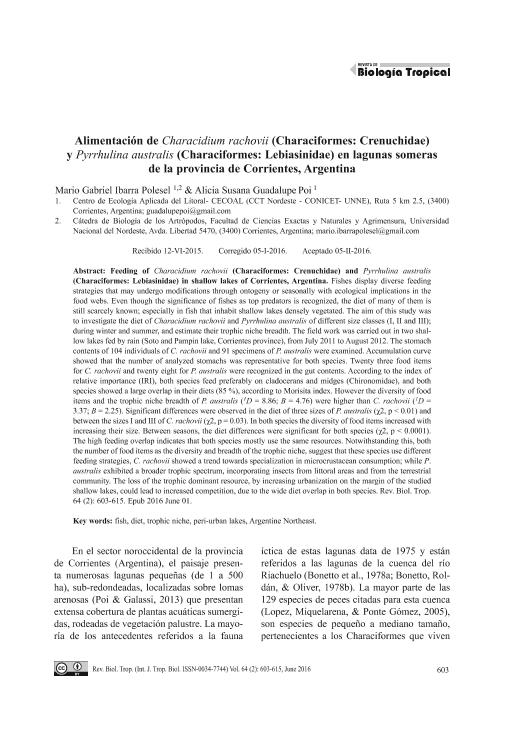Mostrar el registro sencillo del ítem
dc.contributor.author
Ibarra Polesel, Mario Gabriel

dc.contributor.author
Poi, Alicia Susana G.

dc.date.available
2020-04-01T14:25:55Z
dc.date.issued
2016-05
dc.identifier.citation
Ibarra Polesel, Mario Gabriel; Poi, Alicia Susana G.; Alimentación de Characidium rachovii (Characiformes: Crenuchidae) y Pyrrhulina australis (Characiformes: Lebiasinidae) en lagunas someras de la provincia de Corrientes, Argentina; Universidad de Costa Rica; Revista de Biología Tropical; 64; 2; 5-2016; 603-615
dc.identifier.issn
0034-7744
dc.identifier.uri
http://hdl.handle.net/11336/101461
dc.description.abstract
Feeding of Characidium rachovii (Characiformes: Crenuchidae) and Pyrrhulina australis (Characiformes: Lebiasinidae) in shallow lakes of Corrientes, Argentina. Fishes display diverse feeding strategies that may undergo modifications through ontogeny or seasonally with ecological implications in the food webs. Even though the significance of fishes as top predators is recognized, the diet of many of them is still scarcely known; especially in fish that inhabit shallow lakes densely vegetated. The aim of this study was to investigate the diet of Characidium rachovii and Pyrrhulina australis of different sizes classes (I, II and III); during winter and summer and estimate their trophic niche breadth. The field work was carried out in two shallow lakes fed by rain (Soto and Pampin lake, Corrientes province), from July 2011 to August 2012. The stomach contents of 104 individuals of C. rachovii and 91 specimens of P. australis were examined. Accumulation curve showed that the number of analyzed stomachs was representative for both species. Twenty three food items for C. rachovii and twenty eight for P. australis were recognized in the gut contents. According to the index of relative importance (IRI), both species feed preferably on cladocerans and midges (Chironomidae), and both species showed a large overlap in their diets (85%) according to Morisita index. However the diversity of food items and the trophic niche breadth of P. australis (1D=8.86; B=4.76) were higher than C. rachovii (1D=3.37; B=2.25). Significant differences were observed in the diet of three sizes of P. australis (χ2, p<0.01) and between the sizes I and III of C. rachovii (χ2, p=0.03). In both species the diversity of food items increased with increasing their size. Between seasons, the differences in diet were significant for both species (χ2, p <0.0001). The high feeding overlap indicates that both species mostly use the same resources. Notwithstanding this, both the number of food items as the diversity and breadth of the trophic niche, suggest that these species use different feeding strategies, C. rachovii showed a trend towards specialization in microcrustacean?s consumption; while P. australis exhibited a broader trophic spectrum, incorporating insects from littoral areas and from the terrestrial community. The loss of the trophic dominant resource by increases of urbanization on the margin of the studied shallow lakes could lead to increase competition due to the wide overlap in the diet of both species.
dc.format
application/pdf
dc.language.iso
spa
dc.publisher
Universidad de Costa Rica
dc.rights
info:eu-repo/semantics/openAccess
dc.rights.uri
https://creativecommons.org/licenses/by-nc-sa/2.5/ar/
dc.subject
peces
dc.subject
dieta
dc.subject
nicho trófico
dc.subject
lagunas periurbanas
dc.subject
noreste argentino
dc.subject
fish
dc.subject
diet
dc.subject
trophic niche
dc.subject
peri-urban lakes
dc.subject
Argentine Northeast
dc.subject.classification
Ecología

dc.subject.classification
Ciencias Biológicas

dc.subject.classification
CIENCIAS NATURALES Y EXACTAS

dc.title
Alimentación de Characidium rachovii (Characiformes: Crenuchidae) y Pyrrhulina australis (Characiformes: Lebiasinidae) en lagunas someras de la provincia de Corrientes, Argentina
dc.title
Feeding of Characidium rachovii (Characiformes: Crenuchidae) and Pyrrhulina australis (Characiformes: Lebiasinidae) in shallow lakes of Corrientes, Argentina
dc.type
info:eu-repo/semantics/article
dc.type
info:ar-repo/semantics/artículo
dc.type
info:eu-repo/semantics/publishedVersion
dc.date.updated
2020-03-19T14:31:35Z
dc.journal.volume
64
dc.journal.number
2
dc.journal.pagination
603-615
dc.journal.pais
Costa Rica

dc.journal.ciudad
Turrialba
dc.description.fil
Fil: Ibarra Polesel, Mario Gabriel. Consejo Nacional de Investigaciones Científicas y Técnicas. Centro Científico Tecnológico Conicet - Nordeste. Centro de Ecología Aplicada del Litoral. Universidad Nacional del Nordeste. Centro de Ecología Aplicada del Litoral; Argentina. Universidad Nacional del Nordeste. Facultad de Ciencias Exactas y Naturales y Agrimensura; Argentina
dc.description.fil
Fil: Poi, Alicia Susana G.. Consejo Nacional de Investigaciones Científicas y Técnicas. Centro Científico Tecnológico Conicet - Nordeste. Centro de Ecología Aplicada del Litoral. Universidad Nacional del Nordeste. Centro de Ecología Aplicada del Litoral; Argentina
dc.journal.title
Revista de Biología Tropical

dc.relation.alternativeid
info:eu-repo/semantics/altIdentifier/doi/http://dx.doi.org/10.15517/rbt.v64i2.19602
dc.relation.alternativeid
info:eu-repo/semantics/altIdentifier/url/https://revistas.ucr.ac.cr/index.php/rbt/article/view/19602
Archivos asociados
